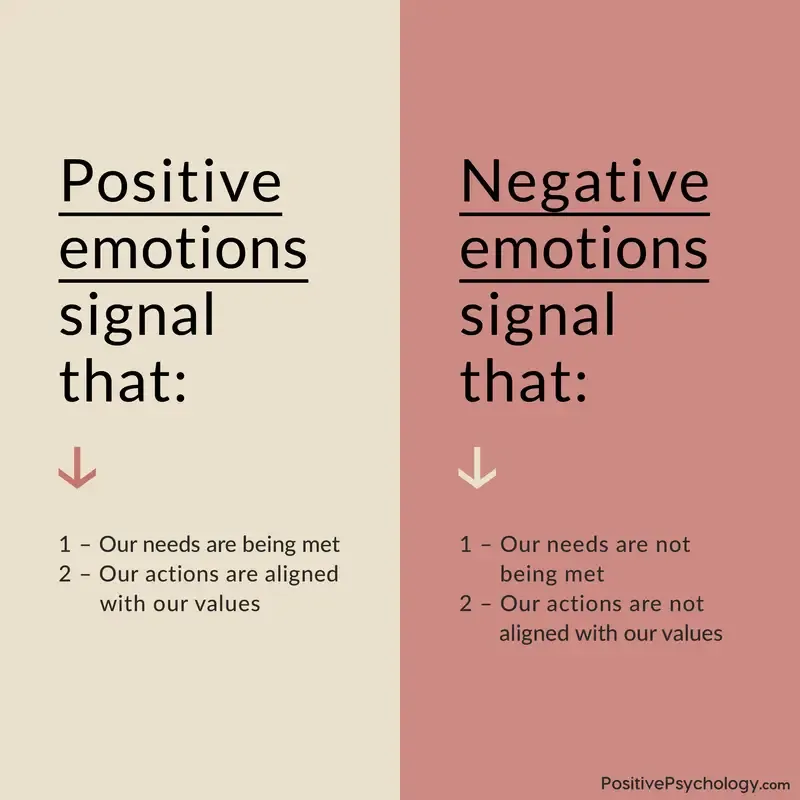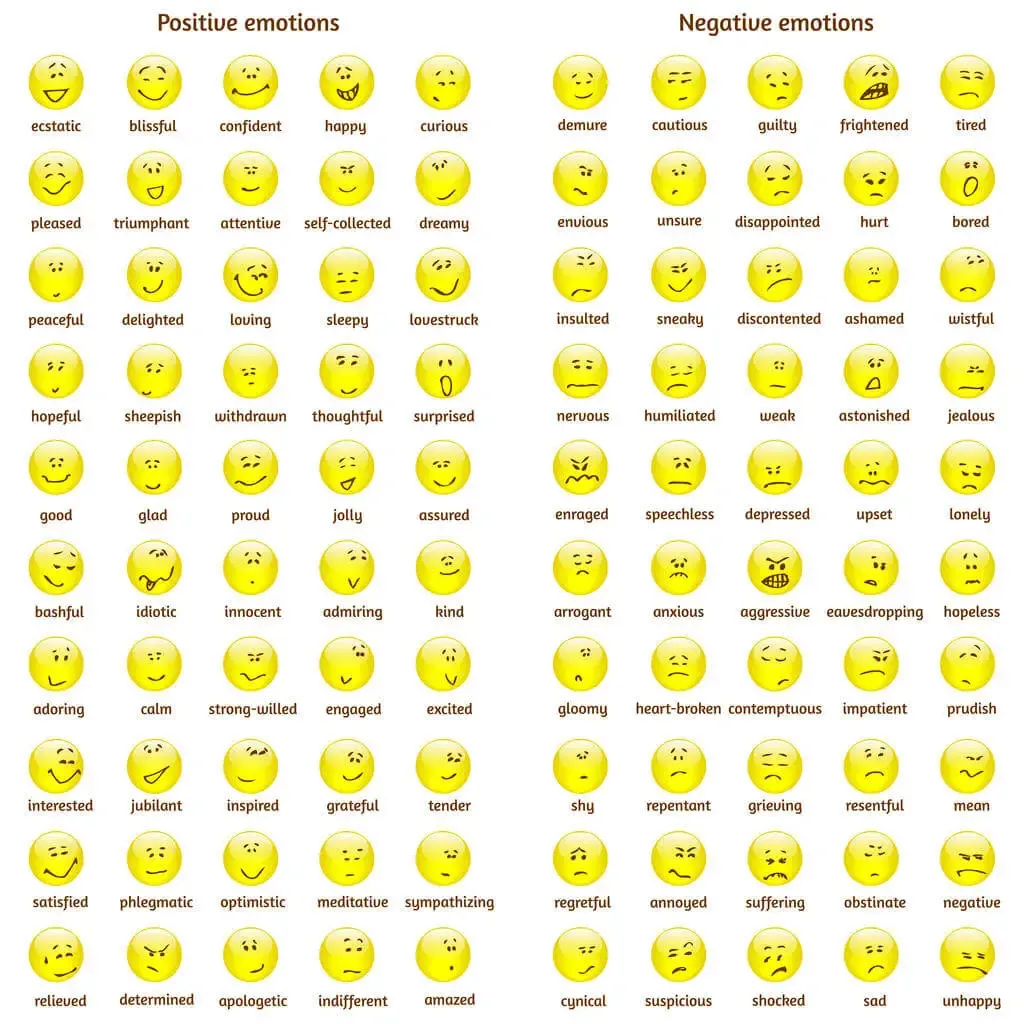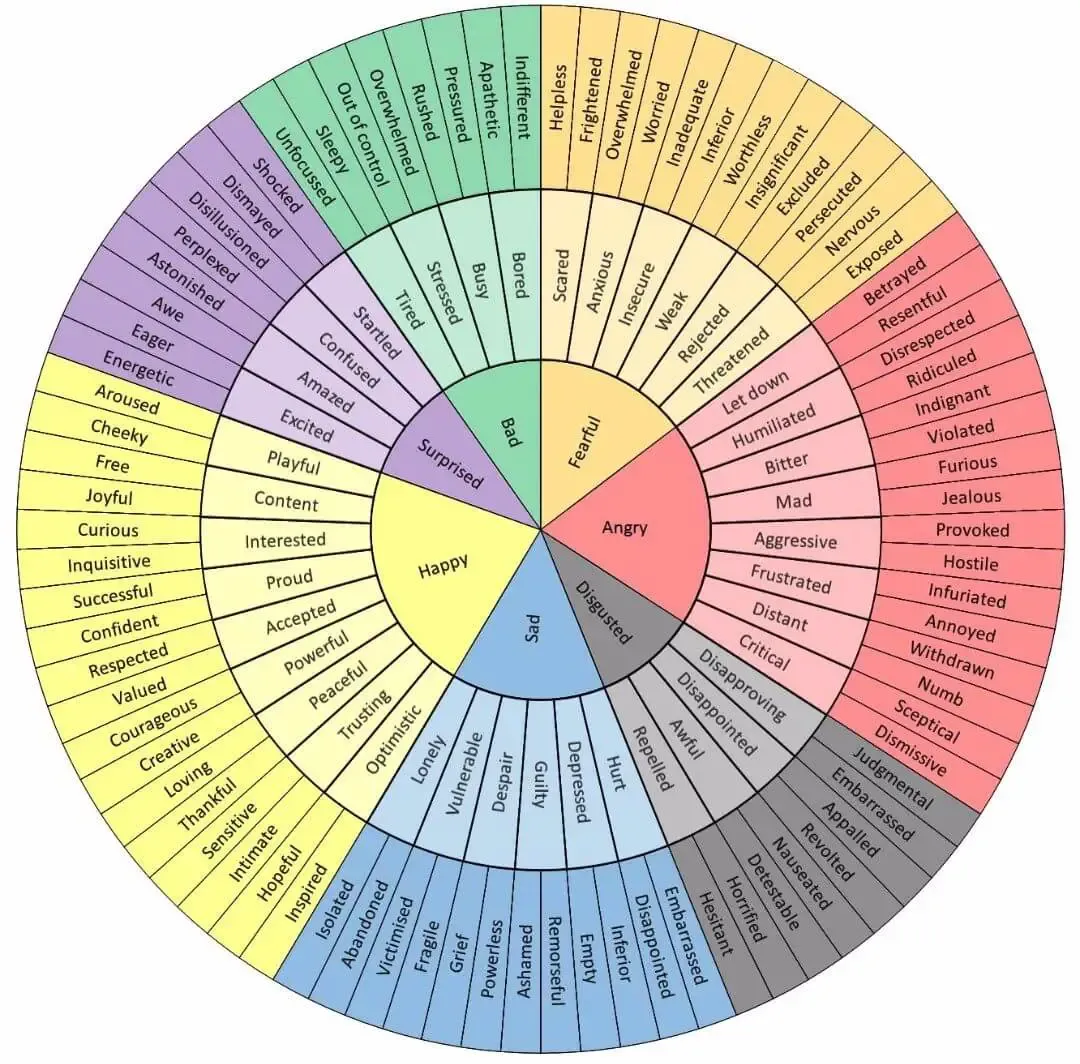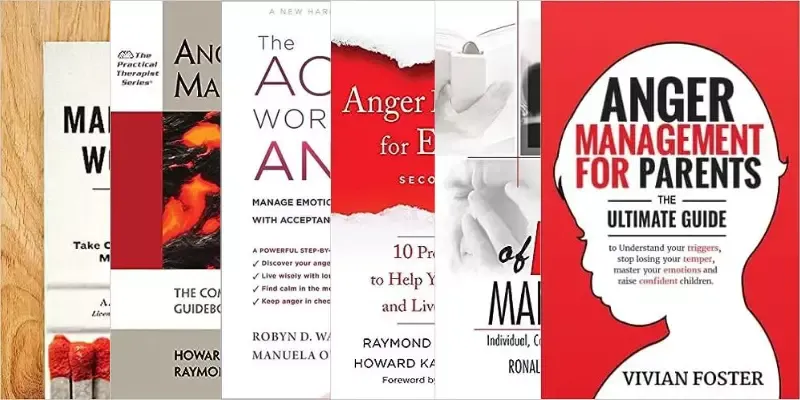What are Positive and Negative Emotions and Do We Need Both?
 You might think that positive psychology is all about positive emotions.
You might think that positive psychology is all about positive emotions.
You’d be forgiven for thinking that, given positive psychology’s inherent positive bent!
But the field isn’t all about positive emotions. Negative emotions are an inevitable part of life and something that we need to experience in order to have a full, rich life.
Why do we need negative emotions to complement the positive ones?
Before you read on, we thought you might like to download our three Emotional Intelligence Exercises for free. These science-based exercises will not only enhance your ability to understand and regulate your emotions but will also give you the tools to foster the emotional intelligence of your clients, students or employees.
This Article Contains:
A Look at the Psychology
People have been studying emotions for thousands of years. Given the heavy focus on feelings, it’s not surprising that we know quite a bit about them; what is surprising is the lack of understanding around the necessity of both emotions for healthy functioning.
Let’s start by defining our terms.
What Are Positive Emotions?
Positive emotions are emotions that we typically find pleasurable to experience. The Oxford Handbook of Positive Psychology defines them as “pleasant or desirable situational responses… distinct from pleasurable sensation and undifferentiated positive affect” (Cohn & Fredrickson, 2009).
Basically, this definition is stating that positive emotions are pleasant responses to our environment (or our own internal dialogue) that are more complex and targeted than simple sensations.
What Are Negative Emotions?
On the other hand, negative emotions are those that we typically do not find pleasurable to experience. Negative emotions can be defined as “as an unpleasant or unhappy emotion which is evoked in individuals to express a negative effect towards an event or person” (Pam, 2013).
If an emotion discourages and drags you down, then it’s most likely a negative emotion.
17 Examples: A List of Positive and Negative Emotions
Examples of positive and negative emotions will vary based on who you ask; even the definition of an emotion can vary based on who answers the question. However you define emotion, discerning between the two is an intuitive process—we seem to “just know” which emotions are positive and which are negative.
Some common positive emotions include:
- Love
- Joy
- Satisfaction
- Contentment
- Interest
- Amusement
- Happiness
- Serenity
- Awe
A few of the most commonly felt negative emotions are:
- Fear
- Anger
- Disgust
- Sadness
- Rage
- Loneliness
- Melancholy
- Annoyance
When we experience negative emotions, we generally are not engaging in actions that align with our values, and our experience is not meeting our needs.
When this happens, we must take a step back, pause, and find ways to attend to this depleted need.
Contrastingly, when we experience positive emotions, it signals that we engage in actions or activities that align with our values. They also suggest that the experience is meeting our needs.
Therefore, we ought to approach them more readily and do them more often in these situations. Imagine an activity that makes you feel joy. Naturally, you would want to move towards that activity and do more of it, helping you further satisfy your needs.

Do We Need Both?
Look back over the list of sample negative emotions. Do you want to feel any of those emotions? You probably don’t, and it’s no wonder! It doesn’t feel good to experience any of those emotions.
Now, refer to the list of sample positive emotions. Have you ever felt one of these emotions and thought to yourself, “I wish I wasn’t experiencing this emotion?” Although you may have experienced this once or twice—generally at a time when we think we shouldn’t feel positive emotions—it’s easy to see that this list is full of pleasurable emotions that people tend to seek out.
We know that we need positive emotions to function effectively, grow, and thrive.
So if it’s basically universally unpleasant for us to experience negative emotions and universally pleasant and desirable to experience positive emotions, do we actually need the negative ones at all?
As it turns out, yes!
Are Negative Emotions Necessary?
Although they are not pleasant to experience, negative emotions really are necessary for a healthy life. This is true for two big reasons:
- Negative emotions give us a counterpoint to positive emotions; without the negative, would the positive emotions still feel as good?
- Negative emotions serve evolutionary purposes, encouraging us to act in ways that boost our chances of survival and help us grow and develop as people.
As Tracy Kennedy from Lifehack.org points out, there is a good reason for each of the basic emotions, both positive and negative:
- Anger: to fight against problems
- Fear: to protect us from danger
- Anticipation: to look forward and plan
- Surprise: to focus on new situations
- Joy: to remind us what’s important
- Sadness: to connect us with those we love
- Trust: to connect with people who help
- Disgust: to reject what is unhealthy (2018)
Without fear, would you be here today? Or would you have engaged in some risky practices, putting yourself in unnecessary danger? Without disgust, would you have been able to refrain from putting any of the many, many harmful substances that you had access to as a toddler?
As unpleasant as they may be, it can’t be denied that negative emotions serve important purposes in our lives.
Is it True that an Individual Will Only Feel Stress in Negative Situations?
Although you may think of stress as a solidly negative emotion or response to a situation, it’s actually quite common for people to experience stress in neutral and positive situations as well.
In fact, many experiences commonly thought of as positive can contribute huge amounts of stress to our lives.
Here are just a few examples of positive experiences that can bring us stress:
- Planning for an upcoming wedding
- Preparing to move to somewhere you are excited to live
- The holidays—especially with family!
- Having a baby
- Starting an exciting new job
It’s perfectly natural to feel stress in all of these situations, even though you would probably classify them as happy and positive. It’s yet another example of the interplay between positive and negative that gives our lives balance.
How to deal with negative emotions – Eckhart Tolle
Positive vs. Negative Emotions: A Look at the Differences
As we now know, positive and negative emotions are both vital for a healthy, well-rounded life. Let’s take a look at how emotions in both categories impact us.
How Do They Affect the Brain?
Positive and negative emotions both have important roles to play when it comes to the brain, but they are generally separate roles.
For example, positive emotions have been shown to impact the brain in the following ways:
- They can increase our performance on a cognitive task by lifting our spirits without distracting us like negative emotions do (Iordan & Dolcos, 2017).
- Positive emotions can trigger the reward pathways in the brain, contributing to lower levels of a stress hormone and greater well-being (Ricard, Lutz, & Davidson, 2014).
- Positive emotions may help us broaden our horizons and widen our brain’s scope of focus (Fredrickson, 2001).
Meanwhile, negative emotions are known to affect the brain in the following ways:
- Facilitating emotional conflict processing, helping us to make sense of incongruent or conflicting emotional information; in other words, negative emotions can help us figure tough emotional problems (Zinchenko et al., 2015).
- Facilitating cognitive conflict processing, aiding us in comprehending incongruent or conflicting cognitive information; in other words, negative emotions can also help us make sense when we receive confusing signals (Kanske & Kotz, 2010; 2011).
- Reducing the experience of empathy, which can help protect us from getting too involved with others and stay focused on our goals (Qiao-Tasserit, Corradi-Dell’Acqua, & Vuilleumier, 2017).
Both have impactful roles to play in our brain, and these roles are complementary rather than competitive.
The Role of Both in Positive Psychology
Given the impact of positive and negative emotions on our thoughts and behaviors, it’s easy to see why positive psychology keeps a close eye on negative emotions in addition to the positive. As vital as it is for us to learn how to boost our positive emotions and take advantage of the opportunities they bring, it’s just as vital to learn how to adapt from negative emotions and cope with them effectively.
When we are able to accept, embrace, and exploit both our positive and our negative emotions, we give ourselves the best chance to live a balanced, meaningful life. This is why the field of positive psychology is hesitant to focus too much on positive emotions alone—it is just as important to understand how to turn negative emotions into a positive experience as it is to capitalize on our positive emotions.
How Can We Best Track Our Emotions?
Now we know about the importance of accepting and managing our emotions—both positive and negative—the next question is how we actually do this.
The first step to effectively managing our emotions is to identify, understand, and find the patterns in our emotional experiences.
Positive and Negative Emotions Chart (PDF)
If you need help identifying positive vs. negative emotions or tracking your own emotions, there are several charts that can help.
Check out the examples below, or make your own if you’re feeling creative.

Simple List of Positive and Negative Emotions:
| Negative | Positive |
|---|---|
| Grief
Sorrow Heartache Sadness Unhappiness Depression Hatred Blame Regret Misery Resentment Threatening Antagonism Anger Fury Hostility Hate Shame Insecurity Self-consciousness Bravado Embarrassment Worry Panic Frustration Pessimistic Cynicism Jealousy Weariness Pain Anxiety Fright Fear |
Interest
Inspiration Enthusiasm Laughter Amusement Empathy Curiosity Cheer Contentment Calmness Serenity Peace Trust Bliss Delight Happiness Pleasure Joy Carefree Ease Satisfaction Fulfillment Hopeful Confidence Optimism Passion Harmony Excitement Gratitude Kindness Affection Love |
Emotion Wheel:
A Brief Look at Neutral Emotions
While positive and negative emotions have received substantial attention from researchers and psychology practitioners, there’s another category of emotions that have been all but ignored in many circles: neutral emotions.
You won’t hear much about these middle ground feelings from psychologists, but they are a much-discussed topic in some Buddhism circles. These emotions are referred to as adukkhamasukha, which can translate to “not painful not pleasant” (Anālayo, 2017). They refer to “a range in the middle part of the spectrum of felt experience… between pain and pleasure… relatively bland and neither distinctly painful nor clearly pleasant” (Anālayo, 2017).
Since neutral feelings are such a mundane topic for most of us, we rarely give them much thought; however, they may be the emotional category where we spend most of our time! Think about your day: how much of it was spent in joy and contentment? How much in anger and sadness? The answer to those questions is likely to be far less time than you had in the day. The emotions you felt the rest of the time were likely neutral.
Although neutral feelings do not have a valence—positive or negative—some say that neutral feelings can be counted as positive feelings, since they are characterized by the absence of pain and suffering.
Whatever you believe about negative emotions, keep them in mind as an important, if oft-forgotten, piece of your emotional experience. Here is more reading about the Buddhist perspective on neutral emotions.
4 PowerPoints on Positive and Negative Emotions
For more information on positive and negative emotions, give these positive psychology PowerPoint presentations a look. (Some are auto-downloads):
- Emotions and Uncontrolled Emotions from the Utah Education Network
- Emotions from Nagarjuna Kalluru at the ISBR Business School
- Emotions, Body, and Brain from M. Guthrie Yarwood at Penn State
- Emotion, Stress, and Health from Carole Wade, Carol Tavris, and Pearson Education
A Take-Home Message
As always, I hope you leave this piece with a little more knowledge than when you began reading. Identifying, accepting, and managing our emotions—both positive and negative—is such an important task for living a healthy and happy life.
Use what you have learned here to enhance your understanding of your own feelings and the feelings of others, and commit to greater awareness and management of your own emotional state. You won’t regret it!
What are your thoughts on the subject? Do you think negative emotions are necessary, or do you think we could do away with them without any adverse effects? What sort of balance do you aim for? Let us know in the comments section below.
Thanks for reading!
We hope you enjoyed reading this article. Don’t forget to download our three Emotional Intelligence Exercises for free.
- Anālayo, B. (2017). What about neutral feelings? Barre Center for Buddhist Studies. Retrieved from https://www.buddhistinquiry.org/article/what-about-neutral-feelings/
- Cohn, M. A., & Fredrickson, B. L. (2009). Positive emotions. In S. J. Lopez and C. R. Snyder (Eds.) The Oxford Handbook of Positive Psychology (2nd ed.).
- Fredrickson, B. L. (2001). The roles of positive emotions in positive psychology: The Broaden-and-Build Theory of positive emotions. American Psychologist, 56, 218-226.
- Iordan, A. D., & Dolcos, F. (2017). Brain activity and network interactions linked to valence-related differences in the impact of emotional distraction. Cerebral Cortex, 27, 731-749. https://doi.org/10.1093/cercor/bhv242
- Kanske, P., & Kotz, S. A. (2010). Modulation of early conflict processing: N200 responses to emotional words in a flanker task. Neuropsychologia, 48, 3661-3664.
- Kanske, P., & Kotz, S. A. (2011). Emotion triggers executive attention: Anterior cingulate cortex and amygdala responses to emotional words in a conflict task. Human Brain Mapping, 32, 198-208.
- Kennedy, T. (2018). Why negative emotions aren’t that bad (and how to handle them). Lifehack. Retrieved from https://www.lifehack.org/articles/communication/how-handle-negative-emotions.html
- Pam, M. S. (2013). Negative emotion. Psychology Dictionary. Retrieved from: https://psychologydictionary.org/negative-emotion/
- Qiao-Tasserit, E., Corradi-Dell’Acqua, C., & Vuilleumier, P. (2017). The good, the bad, and the suffering. Transient emotional episodes modulate the neural circuits of pain and empathy. Neuropsychologia, 116, 99-116.
- Ricard, M., Lutz, A., & Davidson, R. J. (2014). Mind of the meditator. Scientific American. Retrieved from
https://www.law.upenn.edu/live/files/3918-mind-of-the-meditatorpdf - Zinchenko, A., Kanske, P., Obermeier, C., Schröger, E., & Kotz, S. A. (2015). Emotion and goal-directed behavior: ERP evidence on cognitive and emotional conflict. Social Cognitive and Affective Neuroscience, 10, 1577-1587.
- Zinchenko, A., Obermeier, C., Kanske, P., Schröger, E., Villringer, A., & Kotz, S. A. (2017). The influence of negative emotion on cognitive and emotional control remains intact in aging. Frontiers in Aging Neuroscience, 9, 349.
Let us know your thoughts
Read other articles by their category
- Body & Brain (42)
- Coaching & Application (56)
- Compassion (26)
- Counseling (50)
- Emotional Intelligence (24)
- Gratitude (17)
- Grief & Bereavement (21)
- Happiness & SWB (39)
- Meaning & Values (25)
- Meditation (20)
- Mindfulness (44)
- Motivation & Goals (43)
- Optimism & Mindset (32)
- Positive CBT (25)
- Positive Communication (20)
- Positive Education (44)
- Positive Emotions (30)
- Positive Leadership (13)
- Positive Psychology (32)
- Positive Workplace (33)
- Productivity (16)
- Relationships (42)
- Resilience & Coping (34)
- Self Awareness (20)
- Self Esteem (36)
- Software & Apps (22)
- Strengths & Virtues (30)
- Stress & Burnout Prevention (33)
- Theory & Books (44)
- Therapy Exercises (35)
- Types of Therapy (58)





What our readers think
Hello,
I would like to quote your article (APA 7), so I was wondering if you have published this specific article elsewhere or if this is your original post.
I was also wondering, if the article is owned by PositivePsychology.com and I cite the organization as the author or you.
Hi Metka,
Thanks for your question. This is the original post, and although we do own the articles, we give full author rights to the different authors we feature on our site. This means that you should cite the paper as the author 🙂
I hope this helps!
Kind regards,
-Caroline | Community Manager
Thanks for your post it helps me during my school works and research I wish you to keep going on.
Well-written article. Thanks for sharing it. I have been searching for articles like this. Please, is the positive and negative emotions scale available? I am planning to write a paper on subjective well-being, negative, and positive emotions. I hope there are good articles like this available online. Thank you!
Hi Nana,
Glad you enjoyed the article! You can find the PANAS scale and a link to download it in our blog post here.
Hope this helps!
– Nicole | Community Manager
Someone wise told me that all emotions are perfect. They’re there to serve us. They carry important messages to us to move us into action. So how can we say that emotions of anger, fear, etc are negative emotions? Doesn’t it make people misunderstand even more what these emotions are asking them to address by calling them negative emotions? By labeling them as such, doesn’t it make people want to avoid, dismiss, or brush them aside or under the rug – which makes it come back in uglier ways like Sigmund Freud said?
Hi Tony,
You make a great point. While in the popular press it’s typical to refer to emotions as positive and negative, I think scholars have picked up on what you have and make a more nuanced distinction by referring to emotions as ‘pleasant’ or ‘unpleasant’ in terms of their hedonic valence. Perhaps this is a less ‘loaded’ way to refer to this distinction!
– Nicole | Community Manager
I think a more accurate translation of ‘adukkhamasukha’ would be “not happy nor sad”. in this word ‘dukkha’ means “sadness” and ‘sukha’ means “happiness”.
Loved the article 🙂
could there be more examples of positive corresponding with negative and comparison, how the person might present themselves? thank you
Hi Karolina,
You raise a good point. Interestingly, there’s a lot of debate in the emotions literature about whether (and which) emotions have positive and negative opposites. For instance: Is boredom the opposite of interest? It gets a bit tricky when you drill down to specific emotions in this way. However, more general affective states (e.g., tension/stress/anxiety) are often thought to have opposites (e.g., relaxation/ease/calmness).
There’s my two cents and I hope that answers your question or gives you some food for thought!
– Nicole | Community Manager
Very good article about positive and negative emotions. Happy to get new information about neutral emotions. Congratulations.
Hi, this was helpful, I really like the breadth in the emotion wheel but am surprised to see BAD in the green section. Anyone have any insight into why they chose BAD for this section or what you’re supposed to do with that feeling if you land in that section?
Hi Rowena,
I suspect ‘Bad’ is a broad, high-level way to classify the more specific emotions falling under this label. Several of these emotions strike me as being about having insufficient personal resources (e.g., being sleepy, overwhelmed — not having what you need internally to feel comfortable in a situation).
Maybe that helps!
– Nicole | Community Manager
stating that emotions are negative are perpetuating the stigma against feeling those emotions. No one emotion is inherently positive or negative.
Hi Alexa,
Fair point — and certainly not our intention to stigmatize! But when the author referred to emotions as positive or negative, my guess is that they may have been referring to the distinction in scholarly work between positive and negative affect, which is more abut an emotion’s hedonic tone. That is, the terms ‘positive’ and ‘negative’ in this context are synonymous with ‘pleasantness’ vs. ‘unpleasantness’. You can read more about this idea in our post about the Positive and Negative Affect Schedule (PANAS).
Thanks for reading.
– Nicole | Community Manager
I found the article to be useful as I was asked to write down positive and negative emotions from a seminar that I am taking. I think the charts will be useful as I struggle to see what emotions I have had and how crucial they are in life in solving problems. Thank you
Hi Gerald,
Sometimes it’s difficult to find the right words for what we are feeling, so it’s great that the charts were able to prompt your thinking. If you’d like more exercises to develop your emotional competency, we have a free emotional intelligence tool available for download here if you are interested.
All the best.
– Nicole | Community Manager